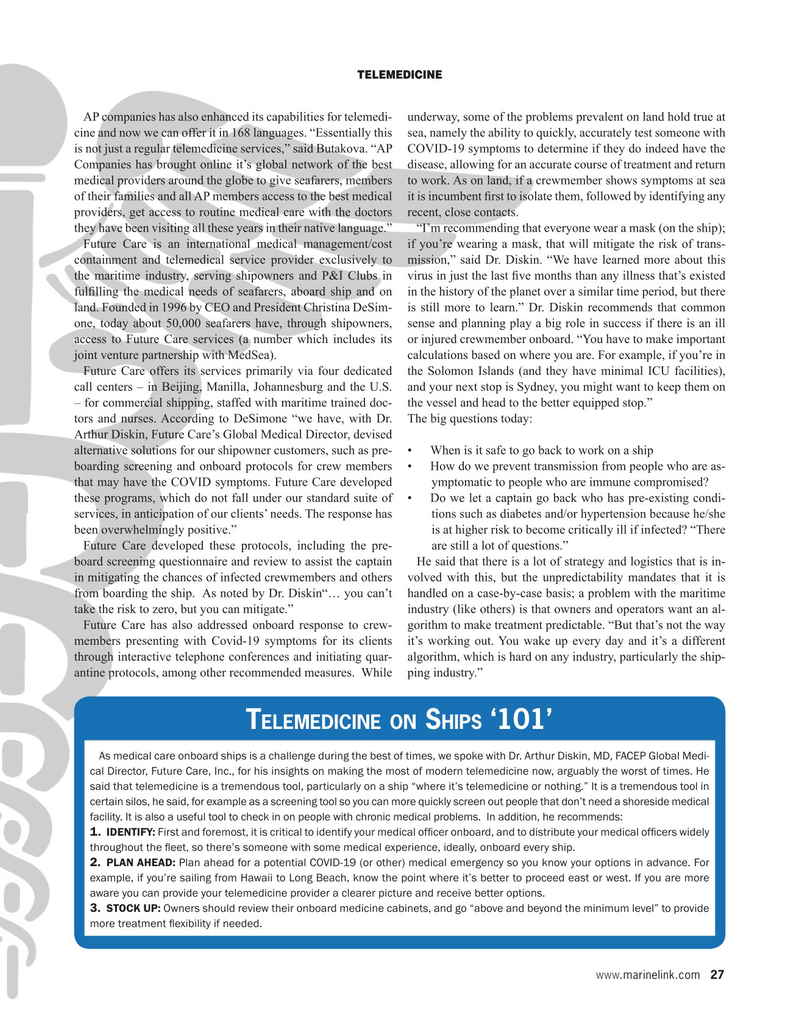
Page 27: of Maritime Reporter Magazine (May 2020)
Fleet Management
Read this page in Pdf, Flash or Html5 edition of May 2020 Maritime Reporter Magazine
Telemedicine
AP companies has also enhanced its capabilities for telemedi- underway, some of the problems prevalent on land hold true at cine and now we can offer it in 168 languages. “Essentially this sea, namely the ability to quickly, accurately test someone with is not just a regular telemedicine services,” said Butakova. “AP COVID-19 symptoms to determine if they do indeed have the
Companies has brought online it’s global network of the best disease, allowing for an accurate course of treatment and return medical providers around the globe to give seafarers, members to work. As on land, if a crewmember shows symptoms at sea of their families and all AP members access to the best medical it is incumbent frst to isolate them, followed by identifying any providers, get access to routine medical care with the doctors recent, close contacts. they have been visiting all these years in their native language.” “I’m recommending that everyone wear a mask (on the ship);
Future Care is an international medical management/cost if you’re wearing a mask, that will mitigate the risk of trans- containment and telemedical service provider exclusively to mission,” said Dr. Diskin. “We have learned more about this the maritime industry, serving shipowners and P&I Clubs in virus in just the last fve months than any illness that’s existed fulflling the medical needs of seafarers, aboard ship and on in the history of the planet over a similar time period, but there land. Founded in 1996 by CEO and President Christina DeSim- is still more to learn.” Dr. Diskin recommends that common one, today about 50,000 seafarers have, through shipowners, sense and planning play a big role in success if there is an ill access to Future Care services (a number which includes its or injured crewmember onboard. “You have to make important joint venture partnership with MedSea). calculations based on where you are. For example, if you’re in
Future Care offers its services primarily via four dedicated the Solomon Islands (and they have minimal ICU facilities), call centers – in Beijing, Manilla, Johannesburg and the U.S. and your next stop is Sydney, you might want to keep them on – for commercial shipping, staffed with maritime trained doc- the vessel and head to the better equipped stop.” tors and nurses. According to DeSimone “we have, with Dr. The big questions today:
Arthur Diskin, Future Care’s Global Medical Director, devised alternative solutions for our shipowner customers, such as pre- • When is it safe to go back to work on a ship boarding screening and onboard protocols for crew members • How do we prevent transmission from people who are as- that may have the COVID symptoms. Future Care developed ymptomatic to people who are immune compromised?
these programs, which do not fall under our standard suite of • Do we let a captain go back who has pre-existing condi- services, in anticipation of our clients’ needs. The response has tions such as diabetes and/or hypertension because he/she been overwhelmingly positive.” is at higher risk to become critically ill if infected? “There
Future Care developed these protocols, including the pre- are still a lot of questions.” board screening questionnaire and review to assist the captain He said that there is a lot of strategy and logistics that is in- in mitigating the chances of infected crewmembers and others volved with this, but the unpredictability mandates that it is from boarding the ship. As noted by Dr. Diskin“… you can’t handled on a case-by-case basis; a problem with the maritime take the risk to zero, but you can mitigate.” industry (like others) is that owners and operators want an al-
Future Care has also addressed onboard response to crew- gorithm to make treatment predictable. “But that’s not the way members presenting with Covid-19 symptoms for its clients it’s working out. You wake up every day and it’s a different through interactive telephone conferences and initiating quar- algorithm, which is hard on any industry, particularly the ship- antine protocols, among other recommended measures. While ping industry.”
T S ‘101’elemedicine on hipS
As medical care onboard ships is a challenge during the best of times, we spoke with Dr. Arthur Diskin, MD, FACEP Global Medi- cal Director, Future Care, Inc., for his insights on making the most of modern telemedicine now, arguably the worst of times. He said that telemedicine is a tremendous tool, particularly on a ship “where it’s telemedicine or nothing.” It is a tremendous tool in certain silos, he said, for example as a screening tool so you can more quickly screen out people that don’t need a shoreside medical facility. It is also a useful tool to check in on people with chronic medical problems. In addition, he recommends: 1. IDENTIFY: First and foremost, it is critical to identify your medical offcer onboard, and to distribute your medical offcers widely throughout the feet, so there’s someone with some medical experience, ideally, onboard every ship.
2. PLAN AHEAD: Plan ahead for a potential COVID-19 (or other) medical emergency so you know your options in advance. For example, if you’re sailing from Hawaii to Long Beach, know the point where it’s better to proceed east or west. If you are more aware you can provide your telemedicine provider a clearer picture and receive better options.
STOCK UP: Owners should review their onboard medicine cabinets, and go “above and beyond the minimum level” to provide 3. more treatment fexibility if needed.
www.marinelink.com 27

 26
26

 28
28
